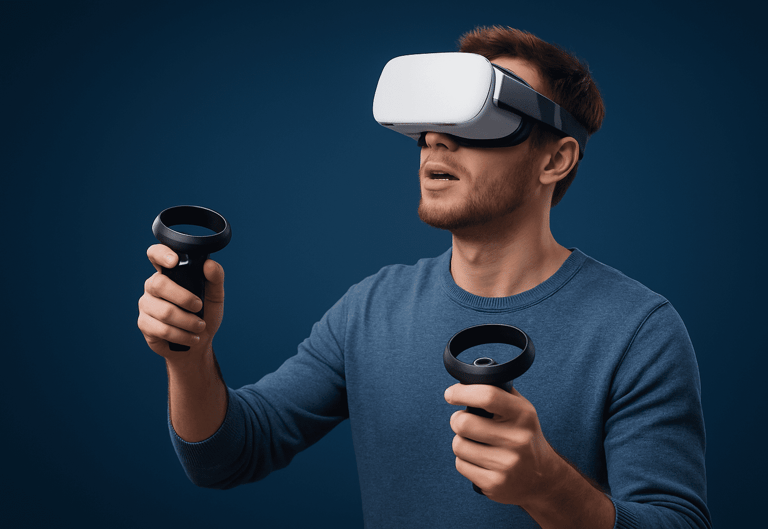Virtual Reality (VR)


What is Virtual Reality?
Virtual Reality (VR) is a technology that creates a simulated environment, allowing users to experience and interact with a computer-generated world as if it were real. Unlike traditional screens, VR immerses you in 360 degrees using a headset equipped with sensors, motion tracking, and sometimes handheld controllers. This makes you feel present inside the digital space, whether it’s exploring a virtual city, playing games, or training for real-life tasks.
VR is widely used in gaming, education, healthcare, real estate, and even job training, making learning and practicing more engaging and realistic. For example, medical students can perform virtual surgeries, or architects can showcase 3D walkthroughs of their designs. The biggest advantage of VR is its ability to blend imagination with reality, creating highly interactive experiences. As the technology evolves, VR is becoming more affordable and accessible, shaping the future of entertainment, work, and learning.
The Future Is Virtual: How VR Is Reshaping Our Everyday Lives
Some decades ago, if you’d asked someone what virtual reality (VR) was, they might’ve pictured a scene from a sci‑fi movie—bulky goggles, weird pixelated worlds, maybe even some robots thrown in for effect. Fast forward to now, and VR isn’t some far‑off fantasy dream anymore. It’s here, it’s happening, and it’s reshaping our everyday life how we live, work, and play every day.
VR Beyond Gaming
When one think's of VR, the first thing that came into their minds is gaming. And honestly, who can blame them? It was the gaming industries that first welcomed VR with open arms. Strapping on a headset and stepping into a fully immersive game world is nothing short of magical. But VR doesn't ends on defeating dragons or racing cars—it’s much more.
Learning in a Whole New Dimension
Imagine you are sitting in a history class and instead of reading from boring text book, you can actually walk its streets, hear the chatter of the marketplace, and even witness the events of the past. VR is shaking up education, turning lessons into adventures instead of dry lines in a textbook. With VR, students get to flew into space, dive beneath the waves, or try out complex science experiments—all without ever leaving their desks.
Remote Work Reimagined
Remember those endless video calls during the pandemic? We all got used to staring at a wall of faces on Zoom, but let’s be real—it felt a little lifeless. This is where VR swoops in. Imagine yourself walking into a virtual office where you can scribble on shared whiteboards, hanging around a digital workspace, or even casually bump into a teammate by the “virtual coffee machine.” Suddenly, remote work doesn’t just feel like logging in to work—it feels like showing up to the work.
Healthcare with a Virtual Touch
Healthcare is one of the most impactful areas where VR is making a real difference. Surgeons using it to rehearse complex procedures, and therapists relying on it to support patients working through phobias or PTSD. It provides a safe, controlled space to practice, heal, and learn all made possible by virtual reality.
Social Connections in Virtual Spaces
We all know staying connected in today’s busy world can be tough cause of all the busy schedules. That’s where VR steps in, offering fresh, exciting ways to socialize. You could slip on a headset and catch a concert with your friends, or just kick back together in a digital lounge. It makes those little moments of “being there” possible, even when life keeps us miles apart.
Where Do We Go From Here?
Sure, VR still has its rough edges. The headsets can feel heavy, and not everyone has easy access to the gear. But as the tech keeps getting lighter, cheaper, and easier to use, it’s only a matter of time before it slides into our everyday lives.
At the end of the day, VR isn’t just a flashy toy—it’s becoming a tool that’s changing industries and helping us connect in new ways. The worlds might be virtual, but the difference it makes is absolutely real.
CONS
There are still some cons lingering to it
Health and Safety Issues
Motion sickness, dizziness, nausea, Eye strain, headaches, Risk of tripping, bumping, or falling in physical space.High Cost
VR headsets, powerful PCs and its accessories are expensive and most of the high quality VR content is also locked behind pay wall which also adds up to the overall cost.Physical Discomfort
VR are not perfect yet , headsets are still bulky which can be tiring when you bear for long period of time.Accessibility Issues
Not suitable for everyone (vision problems, disabilities, vertigo) and requires significant space to move safely.Technical Limitations
We all can agree that it’s not perfect yet , graphics and realism can be improved . Also requires high speed internet for online VR and motion tracking isn’t perfect which can break immersion.

